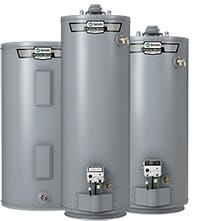Updated August 2023
Hot running water is arguably among the greatest conveniences of modern housing. With its myriads of use in daily activities within our households, from bathing, doing laundry to cleaning utensils, hot water provides untold comfort in our lives. With that being said, we often take these appliances for granted by neglecting their usual maintenance, and we only focus on making minor temperature and settings adjustments.
It’s safe to be conversant with the working principle and parts of these unobtrusive appliances, for we never know when a rainy day may come, and our knowledge may be essential in saving the day. At Environmental Heating & Air Solutions, we specialize in water heater repair and installation in the Northern California area, and we are available when needed.
Below, we’ve compiled a handy outline of the various water heaters available and how they function.
What Are the Different Types of Water Heaters?
There are various types of water heaters available, and they all depend on your house requirements. To correctly identify the type that best suits you, it’s ideal to consider some fundamental questions such as the amount of hot water needed and the type of fuel used, either gas, propane, or electricity. With all these questions figured out, you can choose an appropriate water heating solution that addresses your concerns.
Tank Type Water Heaters
Tank types, also referred to as storage water heaters, have been commonly used in households for generations. Usually, the heater unit is designed with an insulated tank that can hold close to 80 gallons of water and is powered by propane, gas, or electricity. For their high versatility, these tank-type heaters can comfortably be used by almost any household.
Tank-type water heaters comprise the following key components.
1. Flue Pipe
Every water heater that is powered by gas contains a gas burner where combustion occurs. The flue pipe is vital in releasing the waste gases containing harmful carbon monoxide after the combustion process.
2. Coldwater Shut Off Valve
This valve is usually shut down to stop the flow of cold water when there is a need for draining or replacement of the heater.
3. Draft Diverter
The draft diverter is usually a fitting at the end of the flue pipe that collects the waste gasses for safe removal through the flue pipe and outside.
4. Temperature and Pressure Relief Valve (T&P Valve)
This valve plays a role in releasing excess pressure and heat from the water to prevent it from exploding. It’s important to be keen on observing this valve, and if it frequently discharges, it needs immediate replacement.
5. Overflow Pipe
Usually, the overflow pipe is attached to the T&P valve, and both work seamlessly to ensure efficiency in the system. If the T&P valve happens to release excess heat or steam, the overflow pipe facilitates the safe draining of the water away from the heater.
6. Hot Water Outlet
This outlet allows for the exit of the heated water into a portable water supply area for usage.
7. Anticorrosion Anode Rod
Also known as the sacrificial anode, it plays a very significant role in the heater. They are usually installed at the top of the tank and made of aluminum or magnesium, and they contain a steel core. The anode rode sacrifices itself so that the water heater can reach longevity. It does this by attracting particles present in water, such as iron or limestone, through the electrolysis process and corrodes in place of the tank.
It’s advisable by the manufactures to schedule regular inspections of your anode rod every three years, and it should be replaced when it has been consumed almost by 50%. However, you are warned against changing your anode rod yourself since that could void the warranty.
8. Dip Tube
The dip tube extends to the tank bottom and is usually connected to the cold water inlet. Hot water rises to the top, and the purpose of the dip tube is to enable the incoming cold water to settle at the bottom of the water heater. There is a self circulating mechanism in play that allows even water heating and facilitates the circulation of suspended solids, preventing them from settling at the base. The dip tube is a common feature unless the tank’s cold water inlet is situated at the bottom.
9. Elements
These are usually prevalent in electric water heaters and are the basis of water heating for the electric models.
10. Thermostat or Control valve
A thermostat is essential in regulating the heating capabilities of water heaters. The thermostats can be set to either maximum or minimum temperature ranges. Water heaters perform optimally and longer when set at higher temperature ranges, but they need to be tempered down due to scalding issues.
Tankless Water Heaters
Tankless water heaters, also known as on-demand water heaters, are different from the conventional storage type in that they don’t possess a storage tank and heat water on a demand basis. These heaters are efficient since they suffer no heat loss as they don’t contain storage tanks.
An example of such an instance is when a faucet or shower valve in a home is turned on, the tankless water heater turns on and heats the needed water. Their ability to deliver when the need arises makes them an efficient water heating method that saves significant money on energy expenditure.
While these models are available in gas and electric powered varieties, the natural gas-powered model is commonly used since they facilitate the greater flow of heated water. Advisably, if your household consumes quite a large amount of hot water, then the tankless water heater may not address your needs as needed. The reason being they only move a limited number of gallons per minute. Thus you risk being short of water for activities that are happening simultaneously.
Hybrid Water Heaters
These types of water heaters combine the efficiency of tankless water heaters with larger storage capacity. They are designed with a storage tank that has an additional heat pump fitted at the top. The pump draws in cooler air from the environment and directs it toward the insulated tank into a compressor.
The hybrid tanks allow for greater heating efficiency, close to 60% higher than conventional ones. As a result, they offer reduced energy bills. Hybrid tanks are taller due to the heat pump add-on, and they require about seven to eight feet of space for the ideal installation.
At Environmental Heating & Air Solutions, we are also dedicated to providing reliable heating and cooling services in Northern California. We provide air conditioning and repair, maintenance, and installation as well as home insulation services. We also offer indoor air quality and water quality solutions. Be sure to look at our service catalog for more details.
Are you in need of water heater installation or repair services? Contact Environmental Heating & Air Solutions today for an inquiry or to get a quotation.

